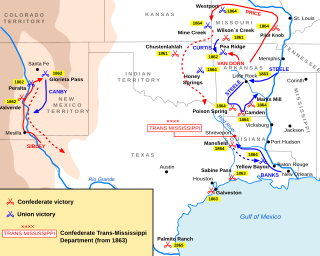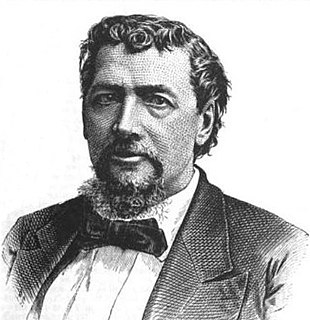
Stand Watie — also known as Standhope Uwatie, Tawkertawker, and Isaac S. Watie — was a leader of the Cherokee Nation, and the only Native American to attain a general's rank in the Confederate States Army during the American Civil War. He commanded the Confederate Indian cavalry of the Army of the Trans-Mississippi, made up mostly of Cherokee, Muskogee and Seminole, and was the final Confederate general in the field to cease hostilities at war's end.
The Battle of Chustenahlah was fought in Osage County, Oklahoma, on December 26, 1861, during the American Civil War. A band of 9,000 pro-Union Native Americans was forced to flee to Kansas in bitter cold and snow in what became known as the Trail of Blood on Ice.

Douglas Hancock Cooper was an American politician, a soldier, an Indian Agent in what is now Oklahoma, and a Confederate general during the American Civil War.

The Battle of Honey Springs on July 17, 1863, was an American Civil War engagement and an important victory for Union forces in their efforts to gain control of the Indian Territory. It was the largest confrontation between Union and Confederate forces in the area that would eventually become Oklahoma. The engagement was also unique in the fact that white soldiers were the minority in both fighting forces. Native Americans made up a significant portion of each of the opposing armies and the Union force contained African-American units.

The Trans-Mississippi Theater of the American Civil War consists of the major military operations west of the Mississippi River. The area is often thought of as excluding the states and territories bordering the Pacific Ocean, which formed the Pacific Coast Theater of the American Civil War (1861-1865).
The Battle of Old Fort Wayne was an American Civil War battle on October 22, 1862 in Delaware County in what is now eastern Oklahoma, a part of the Trans-Mississippi Theater.

John Chupco was a leader of the Hvteyievike, or Newcomer, Band of the Seminole during the time of their forced relocation to Indian Territory. They were the last group to move from Florida to Indian Territory.

The 1st Cherokee Mounted Rifles was a Confederate States Army regiment which fought in the Indian Territory during the American Civil War. It was formed from the merger of two predecessor units the First Regiment of Cherokee Mounted Rifles, and the Second Regiment of Cherokee Mounted Rifles. The first commander was Col. John Drew, while the second was Stand Watie.
Two American Civil War military engagements were fought at the Cabin Creek Battlefield in the Cherokee Nation within Indian Territory. The location was where the Texas Road crossed Cabin Creek, near the present-day town of Big Cabin, Oklahoma. Both the First and Second Battles of Cabin Creek were launched by the Confederate Army to disrupt Union Army supply trains.
The Battle of Middle Boggy sometimes called either Battle of Middle Boggy River or Battle of Middle Boggy Depot, took place on February 13, 1864 in Choctaw Indian Territory, 4 miles (6.4 km) south of what is now Allen in Pontotoc County, Oklahoma. Advancing down the Dragoon Trail toward Fort Washita, Union Colonel William A. Phillips sent out an advance of approximately 350 men from the 14th Kansas Cavalry and two howitzers to attack a Confederate outpost guarding the Trail's crossing of Middle Boggy River. The Confederate force was led by Captain Jonathan Nail and composed of one company of the First Choctaw and Chickasaw Cavalry, a detachment of the 20th Texas Cavalry and part of the Seminole Battalion of Mounted Rifles. The outpost was about 12 miles (19 km) from Muddy Boggy Depot, which was held by the Confederates. The Encyclopedia of Oklahoma History and Culture says that the battlefield was 15 miles northeast of the depot, whereas the battlefield marker says the distance was 12 miles. The Confederate force at the outpost, consisting of 90 poorly armed men, were caught off guard when Willetts attacked them. Outnumbered and outgunned, the Confederates held off the Union cavalry attack for approximately 30 minutes before retreating to the rest of Lt. Col. John Jumper's Seminole Battalion, who were not at the main skirmish. The Confederates retreated 45 miles (72 km) southwest down the Dragoon Trail. The Union advance continued south toward Ft. Washita the next day, but when the expected reinforcements did not arrive Philips' Expedition into Indian Territory stalled on February 15, near old Stonewall.
The Cherokee in the American Civil War were active in the Trans-Mississippi and Western Theaters. In the east, Confederate Cherokees led by William Holland Thomas hindered Union forces trying to use the Appalachian mountain passes of western North Carolina and eastern Tennessee. Out west, Confederate Cherokee Stand Watie led primarily Native Confederate forces in the Indian Territory, in what is now the state of Oklahoma.

Fort McCulloch was a Confederate military fort built by CSA Brigadier General Albert Pike in the Indian Territory during the American Civil War after the Battle of Pea Ridge.

The American Civil War saw Native American individuals, bands, tribes, and nations participate in numerous skirmishes and battles. Native Americans served in both the Union and Confederate military during the American Civil War. They were found in the Eastern, Western, and Trans-Mississippi Theaters. At the outbreak of the war, for example, the majority of the Cherokees sided with the Union, but soon after allied with the Confederacy. Native Americans fought knowing they might jeopardize their sovereignty, unique cultures, and ancestral lands if they ended up on the losing side of the Civil War. 28,693 Native Americans served in the Union and Confederate armies during the Civil War, participating in battles such as Pea Ridge, Second Manassas, Antietam, Spotsylvania, Cold Harbor, and in Federal assaults on Petersburg.
William Weer was a lawyer, attorney general for Kansas and an officer in the Union Army during the American Civil War. He is notable for his service in the Trans-Mississippi Theater early in the war and later for being dismissed from the army following a court-martial.
On the eve of the American Civil War in 1861, a significant number of Indigenous peoples of the Americas had been relocated from the Southeastern United States to Indian Territory, west of the Mississippi. The inhabitants of the eastern part of the Indian Territory, the Five Civilized Tribes, were suzerain nations with established tribal governments, well established cultures, and legal systems that allowed for slavery. Before European Contact these tribes were generally matriarchial societies, with agriculture being the primary economic pursuit. The bulk of the tribes lived in towns with planned streets, residential and public areas. The people were ruled by complex hereditary chiefdoms of varying size and complexity with high levels of military organization.

The ambush of the steamboat J.R. Williams was a military engagement during the American Civil War. It took place on May 10, 1864 on the Arkansas River in Indian Territory which became encompassed by the State of Oklahoma. It is popularly termed the "only naval battle" in that landlocked state. It was a successful Confederate attack on the Union Army's lines of supply. The Confederate forces were Cherokee, Chickasaw, Choctaw and Creek Indians led by General Stand Watie, who was a Cherokee.
Fort Davis, Oklahoma was established in 1861 on the south bank of the Arkansas River two and one-half miles northeast of present-day Muskogee, Oklahoma to serve as a Confederate States of America headquarters in Indian Territory. The fort's name honored President of the Confederate States of America Jefferson Davis. First called Cantonment Davis, its purposes were to help retain the loyalty of the Indian Territory to the Confederacy and to prevent Union Army invasions into Texas from the north.
















